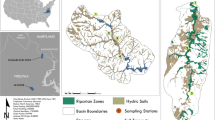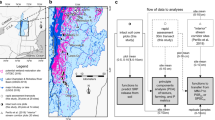Abstract
Everglades National Park (ENP) is the last hydrologic unit in the series of impounded marsh units that make up the present-day Everglades. The ENP receives water from upstream Water Conservation Areas via canals and water control structures that are highly regulated for flood control, water supply, wildlife management, concerns about poor water quality and the potential for downstream ecosystem degradation. Recent surveys of surface soils in ENP, designed for random sampling for spatial analysis of soil nutrients, did not sample proximate to inflow structures and thus did not detect increased soil phosphorus associated with these water conveyances. This study specifically addressed these areas in a focused sampling effort at three key inflow points in northeast ENP which revealed elevated soil TP proximate to inflows. Two transects extending down Shark River Slough and one down Taylor Slough (a natural watershed of particular ecological value) were found to have soil TP levels in excess of 500 mg kg−1—a threshold above which P enrichment is indicated. These findings suggest the negative impact of elevated water (P) from surface flows and support the assertion that significant soil TP enrichment is occurring in Taylor Slough and other areas of northeastern ENP.




Similar content being viewed by others
References
Anderson JM (1976) An ignition method for determination of total phosphorus in lake sediments. Water Research 10:329–331
Amador JA, Jones RD (1995) Carbon mineralization in pristine and phosphorus enriched peat soils of the Florida Everglades. Soil Science 159:129–141
Armentano TV, Sah JP, Ross MS, Jones DT, Cooley HC, Smith CS (2006) Recent responses of vegetation to hydrological changes in Taylor Slough, Everglades National Park, USA. Hydrobiologia 569:293–309
Bostic EM, White JR, Reddy KR, Corstanje R (2010) Evidence of phosphorus distribution in wetland soil after the termination of nutrient loading. Soil Science Society of America Journal 74:1808–1815
Browder J, Ogden JC (1999) The natural South Florida system II: Pre-drainage ecology. Urban Ecosystems 3:125–158
Bruland GL, Grunwald S, Osborne TZ, Reddy KR, Newman S (2006) Spatial distribution of soil properties in Water Conservation Area 3 of the Everglades. Soil Science Society of America Journal 70:1662–1676
Bruland GL, Osborne TZ, Reddy KR, Grunwald S, Newman S, DeBusk WF (2007) Recent changes in soil total phosphorus in the Everglades: Water Conservation Area 3A. Environmental Monitoring and Assessment 129:379–395
Chamber R (2007) Physical and chemical characteristics of soil sediments from the Shark River Slough and Taylor Slough, Everglades National Park, from August 2004, 2005, 2006 and 2007. Resource file LT_SS_Chamber_004. http://fce.lternet.edu/data/core/metadata/?datasetid=LT_SS_Chambers_004. Accessed 30 June 2012
Chambers RM, Pederson KA (2006) Variation in soil phosphorus, sulfur, and iron pools among south Florida wetlands. Hydrobiologia 569:63–70
Chen M, Ma LQ, Li YC (2000) Concentrations of P, K, Al, Fe, Mn, Cu, Zn, and As in marl soils from south Florida. Soil and Crop Sciences Society of Florida Proceedings 59:124–129
Childers DL, Doren RF, Jones RD, Noe GB, Rugge M, Scinto LJ (2003) Decadal change in vegetation and soil phosphorus pattern across the Everglades landscape. Journal of Environmental Quality 32:344–362
Corstanje R, Grunwald S, Reddy KR, Osborne TZ, Newman S (2006) Assessment of the spatial distribution of soil properties in a Northern Everglades marsh. Journal of Environmental Quality 35:938–949
Davis SM (1994) Phosphorus inputs and vegetation sensitivity in the Everglades. In: Davis SM, Ogden JC (eds) Everglades: The ecosystem and its restoration. St. Lucy Press, Delray Beach, p 826
Davis SM, Ogden JC (eds) (1994) Everglades: the ecosystem and its restoration. St. Lucy Press, Delray Beach, p 826
Daoust RJ, Childers DL (2004) Ecological effects of low level phosphorus additions on two plant communities in a neotropical freshwater wetland. Oecologia 141:672–686
DeBusk WF, Reddy KR, Koch MS, Wang Y (1994) Spatial patterns of soil phosphorus in Everglades Water Conservation Area 2A. Soil Science Society of America Journal 58:543–552
Doren RF, Armentano TV, Whiteaker LD, Jones RD (1997) Marsh vegetation patterns and soil phosphorus gradients in the Everglades ecosystem. Aquatic Botany 56:145–163
Gaiser EE, Childers DL, Jones RD, Scinto LJ, Trexler JC (2006) Periphyton responses to eutrophication in the Florida Everglades: cross-system patterns of structural and composition change. Limnology and Oceanography 51:617–630
Gaiser EE, McCormick PV, Hagerthey SE, Gottleib AD (2011) Landscape patterns of periphyton in the Florida Everglades. Critical Reviews in Environmental Science and Technology 41(S1):92–120
Koch MS, Reddy KR (1992) Distribution of soil and plant nutrients along a trophic gradient in the Florida Everglades. Soil Science Society of America Journal 56:1492–1499
Marchant BP, Newman S, Corstanje R, Reddy KR, Osborne TZ, Lark RM (2009) Spatial monitoring of a non-stationary soil property: Phosphorus in a Florida water conservation area. European Journal of Soil Science 60:757–769
Miao SL, Sklar FH (1998) Biomass and nutrient allocation of sawgrass and cattail along a nutrient gradient in the Florida Everglades. Wetlands Ecosystem and Management 5:245–264
Moustafa MZ, White JR, Coghlan C, Reddy KR (2011) Influence of hydropattern and vegetation type on phosphorus dynamics in flow-through wetland treatment systems. Ecological Engineering 37:1369–1378
Newman S, Grace JB, Koebel JW (1996) Effects of nutrients and hydroperiod on Typha, Cladium, and Eleocharis: implications for Everglades restoration. Ecological Applications 6:774–783
Newman S, Reddy KR, DeBusk WF, Wang Y (1997) Spatial distribution of soil nutrients in a northern Everglades marsh: Water Conservation Area 1. Soil Science Society of America Journal 61:1275–1283
Newman S, Schuette J, Grace JB, Rutchey K, Fontaine T, Reddy KR, Pietrucha M (1998) Factors influencing cattail abundance in the northern Everglades. Aquatic Botany 60:265–280
Noe GB, Childers DL, Jones RD (2001) Phosphorus biogeochemistry and the impact of phosphorus enrichment: Why is the Everglades so unique? Ecosystems 4:603–624
Ogden JC (2005) Everglades ridge and slough conceptual ecological model. Wetlands 25:810–831
Obeysekera J, Browder JA, Hornung L, Harwell MA (1999) The natural South Florida system I: Climate, geology, and hydrology. Urban Ecosystems 3:223–244
Osborne TZ, Bruland GL, Newman S, Reddy KR, Grunwald S (2011a) Spatial distributions and eco-partitioning of soil biogeochemical properties in Everglades National Park. Environmental Monitoring and Assessment 183:395–408
Osborne TZ, Newman S, Kalla P, Scheidt DJ, Bruland GL, Cohen MJ, Scinto LJ, Ellis LR (2011b) Landscape patterns of significant soil nutrients and contaminants in the Greater Everglades Ecosystem: Past, Present, and Future. Critical Reviews in Environmental Science and Technology 41(6):121–148
Qualls RG, Richardson CJ (1995) Forms of soil phosphorus along a nutrient enrichment gradient in the northern Everglades. Soil Science 160:183–197
Reddy KR, DeLaune R, DeBusk WF, Koch MS (1993) Long term nutrient accumulation rates in the Everglades. Soil Science Society of America Journal 57:1147–1155
Reddy KR, Newman S, Grunwald S, Osborne TZ, Corstanje R, Bruland G, Rivero R (2005) Spatial distribution of soil nutrients in the Greater Everglades Ecosystem. Final Report. South Florida Water Management District, West Palm Beach
Reddy KR, Wang Y, DeBusk WF, Newman S (1994) Physico-chemical properties of soils in Water Conservation Area 3 (WCA-3) of the Everglades. Final Report. South Florida Water Management District, West Palm Beach
Reddy KR, White JR, Wright A, Chua T (1999) Influence of phosphorus loading on microbial processes in the soil and water column of wetlands. In: Reddy KR, O’Connor GA, Shelske CL (eds) Phosphorus biogeochemistry of subtropical ecosystems. Lewis Publishers, New York, pp 249–273
Rivero RG, Grunwald S, Osborne TZ, Reddy KR, Newman S (2007) Characterization of the spatial distribution of soil properties in Water Conservation Area 2A, Everglades. Florida Soil Science 172:149–166
Scheidt DJ, Kalla PI (2007) Everglades ecosystem assessment: water management and quality, eutrophication, mercury contamination, soils and habitat: monitoring for adaptive management: a R-EMAP status report. USEPA Region 4, Athens, EPA 904-R-07-001. 98 pp
Scheidt, DJ, Flora, MD, Walker, DR (1989) Water quality management for Everglades National Park. In: Wetland: concerns and successes. American Water Research Association, Bethesda, MD, pp 377–390
Scheidt DJ, Stober J, Jones R, Thornton K (2000) South Florida ecosystem assessment: Everglades water management, soil loss, eutrophication and habitat. US Environmental Protection Agency, Athens, Report No. 904-R-00-003
SFWMD (South Florida Water Management District) (1992) Surface water improvement and management plan for the Everglades. Supporting information Document. South Florida Water Management District, West Palm Beach
Surratt DD, Shinde D, Aumen NG (2012) Recent cattail expansion and possible relationships to water management: changes in upper Taylor Slough (Everglades National Park, Florida, USA). Environmental Management 49:720–733
US Environmental Protection Agency (1993) Methods for the determination of inorganic substances in environmental samples. Environmental Monitoring Systems Lab, Cincinnati
US Geological Survey (2008) Everglades Depth Estimation Network (EDEN). Online database http://sofia.usgs.gov/eden. Accessed 2 Jul 2012
Walker WW (1991) Water quality trends at inflows to Everglades National Park. Water Resources Bulletin 27:59–72
Acknowledgments
This work was supported by funding from the National Park Service. The authors would like to thank Terry Jones of Aircoastal Helicopters for field logistics. This publication was produced as part of a special issue devoted to investigating the ecological response of over 20 years of hydrologic restoration and active management in the Taylor Slough drainage of Everglades National Park. Support for this special issue was provided by: Everglades National Park; the Southeast Environmental Research Center of Florida International University; the Florida Coastal Everglades Long-Term Ecological Research program (National Science Foundation cooperative agreement #DBI-0620409); the Everglades Foundation; and the South Florida Water Management District. This work was completed in Everglades National Park under authorization of Scientific Collection Permit EVER-2007-SCI-0050.
Author information
Authors and Affiliations
Corresponding author
Rights and permissions
About this article
Cite this article
Osborne, T.Z., Reddy, K.R., Ellis, L.R. et al. Evidence of Recent Phosphorus Enrichment in Surface Soils of Taylor Slough and Northeast Everglades National Park. Wetlands 34 (Suppl 1), 37–45 (2014). https://doi.org/10.1007/s13157-013-0381-5
Received:
Accepted:
Published:
Issue Date:
DOI: https://doi.org/10.1007/s13157-013-0381-5




